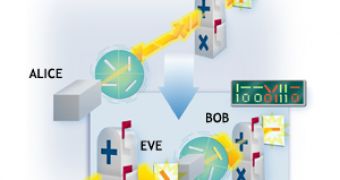Quantum keys are the latest development in encryption technology. Quantum cryptography uses quantum mechanics for secure communications. Unlike traditional cryptography - which depends on the computational complexity of mathematical techniques to restrict the possibility that eavesdroppers might learn the contents of encrypted messages - quantum cryptography depends on the fact that naive attempts to read quantum information will destroy the information (there is no way to copy unknown quantum states).
A new demonstration of how to transmit these quantum keys set a world record in distance. A team of researchers from the National Institute of Standards and Technology (NIST), NTT Corp. in Japan, and Stanford University, were able to transmit quantum key over a record-setting 200-kilometer fiber-optic link.
The new method only used standard components and transmitting at telecommunications frequencies and paves the way for new, practical applications like inter-city terrestrial quantum communications networks as well as long-range wireless systems using communication satellites.
Whereas classical public-key cryptography relies on the computational difficulty of certain hard mathematical problems (such as integer factorization) for key distribution, quantum cryptography relies on the laws of quantum mechanics. Quantum cryptographic devices typically employ individual photons of light and take advantage of either the Heisenberg uncertainty principle or quantum entanglement.
The new experiment was performed with optical fiber wrapped around a spool, and it not only set the distance record for quantum key distribution (QKD), but it was also the first to transmit information at a rate of 10 billion light pulses per second, to produce secure keys.
The current commercial systems are aimed mainly at governments and corporations with high security requirements, and properly executed, quantum encryption is "unbreakable" because eavesdropping changes the state of the photons.
Sae Woo Nam is a physicist who worked on the experiment, and concluded that "You need to know how to efficiently get light to the detector and how to amplify the signals."

 14 DAY TRIAL //
14 DAY TRIAL //